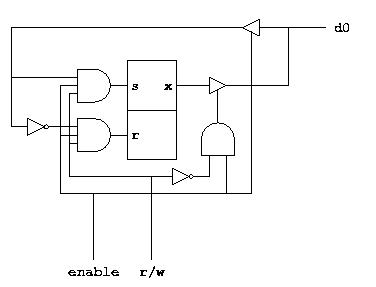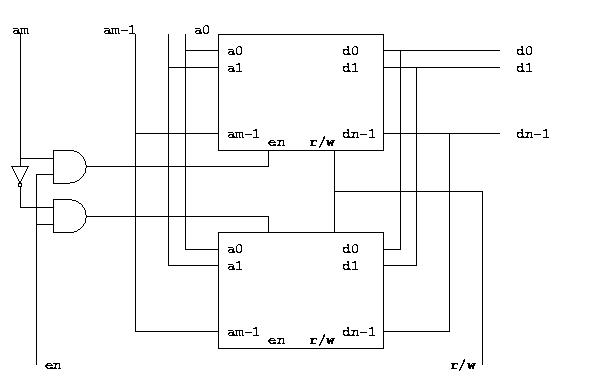|
A memory is neither a
sequential circuit (since we require sequential circuits to be
clocked, and memories are not clocked), nor a
combinatorial circuit, since its output values depend on past
values.
In general, a memory has m inputs that are called the
address inputs that are used to select exactly one out of 2m
words, each one consisting of n bits.
Furthermore, it has n connectors that are
bidirectional that are called the data lines. These
data lines are used both as inputs in order to store
information in a word selected by the address inputs, and as
outputs in order to recall a previously stored value. Such a
solution reduces the number of required connectors by a factor two.
Finally, it has an input called enable (see
the section on tri-state logic for an explanation) that controls
whether the data lines have defined states or not, and an input
called r/w that determines the direction of the data lines.
A memory with an arbitrary value of m and an arbitrary
value of n can be built from memories with smaller values
of these parameters. To show how this can be done, we first show how
a one-bit memory (one with m = 0 and n = 1) can be
built. Here is the circuit:

The central part of the circuit is an SR-latch that holds one bit
of information. When enable is 0, the
output d0 is isolated both from the inputs
to and the output from the SR-latch. Information is passed from
d0 to the inputs of the latch when
enable is 1 and r/w is 1
(indicating write). Information is passed from the output
x to d0 when enable
is 1 and r/w is 0 (indicating
read).
Now that we know how to make a one-bit memory, we must figure out
how to make larger memories. First, suppose we have n
memories of 2m words, each one consisting of a
single bit. We can easily convert these to a single memory with 2m
words, each one consisting of a n bits. Here is
how we do it:

We have simply connected all the address inputs together, all the
enables together, and all the read/writes together. Each one-but
memory supplies one of the bits of the n-bit word in the
final circuit.
Next, we have to figure out how to make a memory with more words.
To show that, we assume that we have two memories each with m
address inputs and n data lines. We show how we can connect
them so as to obtain a single memory with m + 1 address
inputs and n data lines. Here is the circuit:

As you can see, the additional address line is combined with the
enable input to select one of the two smaller memories.
Only one of them will be connected to the data lines at a time
(because of the way tri-state logic works). |